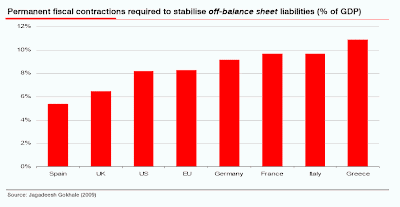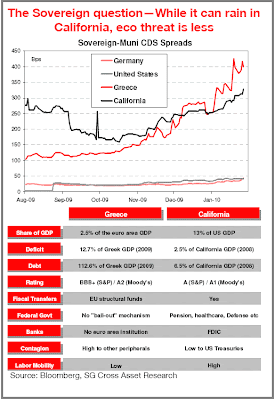According to
Bloomberg today:
Feb. 4 (Bloomberg) -- Nassim Nicholas Taleb, author of “The Black Swan,” said “every single human being” should bet U.S. Treasury bonds will decline, citing the policies of Federal Reserve Chairman Ben S. Bernanke and the Obama administration.
It’s “a no brainer” to sell short Treasuries, Taleb, a principal at Universa Investments LP in Santa Monica, California, said at a conference in Moscow today. “Every single human being should have that trade.”
Ufff! Scared? Well,
Felix Salmon has an interpretation of Taleb's words:
Taleb isn’t actually giving investment advice here, although it might sound as though he is. He’s just making a rhetorical point that Bernanke and Summers are bound to make some kind of a mistake in trying to steer the US economy — and that such mistakes are likely to result in higher long-term rates. The problem is that, as we saw during the most recent crisis, every so often an economic disaster results in lower long-term rates. So overall I’d say that following Nassim’s investment advice from his book is definitely preferable to following off-the-cuff comments he’s making in Moscow.
Not convinced by Salmon's interpretation? Interestingly, but I look at 10-year US Treasuries in my screens right now, and we are trading close to the lowest
intra-day yield of ca. 3.60%, but we were at 3.71% in the European morning today. Gold was also thrown down from (spot) 1110
USD in the European morning to 1062 as I write. Of course, the markets have been flooded with
bond market bubble fear now. Also Australian equity strategists at
Citigroup Global Markets had a refreshing reminder of
bond market collapse of 1994 last week. The key messages were as follows:
Unlikely, but Beware — The massive sell off in bonds yields through 1994 caught the market by surprise. Even with the benefit of hindsight, it was not “obvious” in the way we now view equity market corrections of late 1987, 2000 and 2008.
Similarities to Now — Leading into 1994, economies were in upgrade mode with equity markets performing strongly. The Fed funds rate had been kept at a (then) record low for an extended period of time so as to nurse US commercial banks and the property market off the critically ill list.
Warning Signs — Look for upward movements in US Fed fund futures, an increase in long term inflation rate expectations, underperformance by US treasuries and hawkish central bank commentary as signals of a potential repeat.
Click on chart to enlarge, courtesy of
Citigroup.

Well, from historical perspective the jump in yields in 1994 does not look that big at all. Further, we have discussed the bond market collapse of 1994 behind the scenes in the meantime. The key finding so far are:
... contrary to 1994 when no one believed it should come/crash it appears that most believe that bonds can only collapse this time around!
... they appear very eager to buy interest rate caps i.e. this is an expression of fear of an upcoming bond bear market. Again, this attitude is very different to the end-1993/early 1994 sentiment where "everyone" believed that the 1993 bull market should carry on (forever).
So far it looks different to 1994. And it is not only
about the Greece or
PIIGS in the
Eurozone, but
also other fiscal jokes.
Behind the sovereign debt background, there are some issues in the credit markets worth mentioning. According to
BNP Paribas credit strategists:
Within corporate credit, financials have been the main underperformers, particularly in CDS, with the spread between iTraxx Senior Financials and Main hitting 12bp – a higher differential than after Lehman's demise.
Click on chart to enlarge, courtesy of
BNP Paribas.

Credit jokes?

























